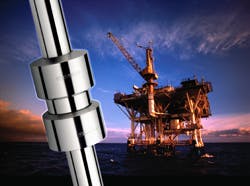Conducting rebuilds and refurbishment in off-shore applications is often a difficult, time-consuming task, so any system that can simplify the process is a welcome addition. The instrumentation division of Parker Hannifin Corp. offers one such component — its Phastite tube fittings, which provide a new system building approach for high-pressure offshore and subsea hydraulics and fluid applications. Using Phastite fittings can slash assembly time, reduce tube material costs, and eliminate 'hot work.'
Parker Instrumentation's high-pressure tube fitting, Phastite, can reduce assembly times for permanent connections by 20 fold or more compared with welding or cone-and-thread tube fittings, and eliminate any need for hot work permits.
The Phastite system is already being used in numerous offshore applications, from new builds to repairs and refurbishment. Recently, they were used to simplify changes to heavy-wall, 1-in. pipe hydraulic services on a working production platform in the North Sea. Phastite fittings eliminated the need for a hot work permit and associated costly downtime.
Quicker assembly for higher pressures
Phastite connectors can reduce assembly times for permanent connections by 20 fold or more compared with welding or cone-and-thread tube fittings, and eliminate any need for hot work permits. Moreover the fittings are designed to withstand working pressures up to 1379 bar (20,000 psi), providing a highly cost-effective solution for the demanding higher pressure hydraulic and instrumentation applications that are increasingly being faced in the offshore oil and gas sector.
Many applications can be found on the topsides of today's platforms, as well as on support vessels and subsea equipment and ROVs. These include hydraulic systems for wellhead control, emergency shut down, chemical injection, pumping packages, gas booster systems, and test equipment. Phastite tube fittings can also deliver substantial material cost and weight savings as the connections do not need to be used with more expensive tubing with extra thickness to accommodate a thread — as is the case with cone and thread fittings. Phastite fittings are also inherently resistant to vibration and do not require anti-vibration accessories.
The company has recently expanded the range of Phastite fittings, so they are now available for all fluid connector sizes and shapes and assembly tools, for metric or imperial tube or pipe applications up to 1 in. /25 mm.
Compression makes sealing a cinch
Phastite fittings employ a compression assembly principle using a novel form of toothed profile, which makes the seal. The fittings are supplied as one-piece components. To make a joint, all that is required is to insert the tube, and then push the collar along the fitting body until it reaches a dead stop. This operation is performed by a simple handheld hydraulic tool, and takes a few seconds. The tool requires no skill to use, and assures users of right-first-time connections.
Phastite's sealing mechanism is based on a series of defined internal ridges that create a secure seal, by radial compression, without weakening the tubing surface. The ridges effectively grip in a way that retains all of the tubing’s strength.
Keeping vibration at bay
These profiles also make the fitting particularly suitable for vibration prone environments. For example, in testing to verify conformance with BS 4368 (which calls for 20 million vibration cycles at between 23 and 47 Hz - some 238 hours of testing in total), Phastite fittings were left on the rig until destruction. The fittings still retained their seal even in excess of 400 hours, and at this point, the test frequency was increased far beyond the range of the standard, and the fittings continued to operate for another 40 hours. Tolerance of vibration (as well as shocks) is a critical area of performance in ROV applications for example. The maintenance free nature of a Phastite connection is an additional highly valued characteristic for this area and other subsea applications.


